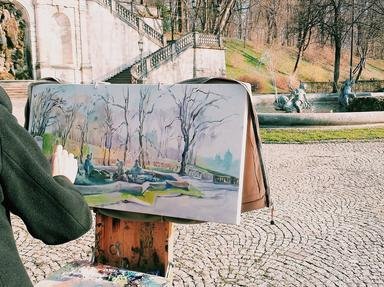Quiz Answer Key and Fun Facts
1. One of the most marvelous and gifted portraitists of the early Renaissance was Hans Holbein the Younger. His portraits, including those of Henry VIII and several of his wives, help to give us a detailed look at his subjects. One of his subjects was the Renaissance intellect 'Erasmus of _______'. From whence did the famed Renaissance scholar, and sitter for Holbein, come?
2. The mysterious Venetian artist called Giorgione never signed a painting, but about twenty known paintings have been attributed to his hand. One of his most famous works is of a naked woman nursing her child while an onlooking soldier stands nearby. In the background, lightning crackles above a gentle town. The one word title of this painting is 'The ______.'
3. Caravaggio, one of the true characters in the history of painting, was a specialist in the technique known as chiaroscuro. The intense realism within his work is perhaps best characterized in the painting called '______ Thomas', created in 1599. What completes the title of this masterpiece?
4. Piet Mondrian's characteristic style involved grids, typically outlined with black lines, and featuring primary colored rectangles and squares. In his piece called '_______ Boogie Woogie', the grid is composed of mostly yellow lines, with blocks of blue, red and gray interspersed. What name fits the blank in the title of this Mondrian work?
5. One of the most stunning works of the 17th century was painted by Cristofano Allori, and can be found in the Pitti Palace in Florence. Featuring a very common theme in Renaissance art, the painting is entitled 'Judith with the Head of _______'. Fill in the blank with the correct name.
6. Of the many famous paintings by American artists, perhaps none surpass in notoriety the most well-known work by James Abbott McNeill Whistler, commonly called 'Whistler's Mother'. The painting is alternatively known as 'Arrangement in ____ and ____, #2.' What two colors fit the blanks?
7. Vincent van Gogh, inheritor of the artistic traditions created by the French Impressionists, is often said to have been the inspiration behind the Expressionist movement. One of his most famous paintings was his 'Portrait of Dr. _____', a work he did of his doctor in 1890. What was the good doctor's surname?
8. William Blake was most well-known for his poetry, and perhaps rightly so. But Blake was not only an excellent poet, he also established himself as a masterful painter, albeit one who ignored the conventional rules of painting. One of his watercolors, entitled 'The _____ of Days', exemplifies his unique style. Which of these words completes the title?
9. Titian, often considered the greatest Venetian master, painted two large-scale works that can now be found in the church of Sta. Maria dei Frari in Venice. One is his famous 'Assumption of the Virgin', and the other is called 'The ______ Altarpiece'. What family name finishes the title of this second great work?
10. Duccio, the father of Sienese art, is probably most well-known for his 'Maesta', which is located in Siena's cathedral museum. Another of his best known works was 'The ______ Madonna', which can be discovered by art lovers in the Uffizi Gallery in Florence. Which of these finishes the title of this great Duccio work?
Source: Author
thejazzkickazz
This quiz was reviewed by our editing team before going online.
Any errors found in FunTrivia content are routinely corrected through our feedback system.

